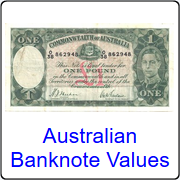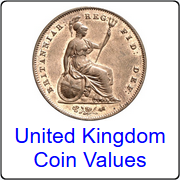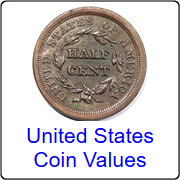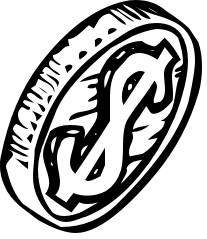European Coin Grading System
European Coin
Grading System
How to evaluate collectible coins using the
European Coin Grading System.
Coin grading systems were created
to try to bring about a standardised,
methodical approach to evaluating a
coins state of preservation.
Many countries have their own
versions or systems, however two
primary systems have been adopted
by most of the western world:
The European System, and the





| Abbr. | Description |
Original design remaining |
| G | Good |
10% |
| VG | Very Good |
25% |
| F | Fine |
50% |
| VF | Very Fine |
75% |
| EF/XF | Extremely Fine |
90% |
| aUnc | about Uncirculated |
95% + some lustre |
| Unc | Uncirculated |
100% + some lustre |
| Gem/BU | Gem or Brilliant Unc |
100% + full lustre |
A demonstration
of the European
Coin Grading System in action
can be found at
the site below.
Where a coin is assessed as between grades,
prefixes are sometimes used to indicate 'nearly',
or 'a bit better than', as follows:
'aVF' may be used to indicate 'about Very Fine',
or 'almost Very Fine'.
(not quite VF, but close, and better than 'good Fine').
'gVF' may be used to indicate 'good Very Fine'.
(a bit better than 'Very Fine', but not good enough
to be 'about Extremely Fine'.)
Often coin sides wear unevenly, or were better struck on one side than the other.
In such cases, it is not uncommon to see people state individual grades for each side
of a coin. This is referred to as 'split grading'.
When this is done, convention is that the obverse, (front, heads), is stated first, then
the reverse, (back, tails), as follows:
'VF/F' would indicate that the obverse, (heads), has been assessed as 'Very Fine',
while the reverse, (tails), has been assessed as 'Fine'.
The European system is less defined than the Sheldon System, however takes a
more conservative approach than the Sheldon system. For example, a coin grading
at 'VF20' using the Sheldon system is likely to be assessed as closer to a 'Fine',
or 'good Fine' using the European method.
It needs to be stressed from the outset that coin and banknote grading is subjective.
Many very experienced graders may look at the same coin and come up with
different assessments, sometimes up to a whole grade, or more.
Grade often does not really take in to account detractors, although many will state a
coin as 'ungradable' if it has significant detractors, such as cleaning, bumps,
scratches, holes, or corrosion.
One technique of evaluating such coins is to state 'detail to .......', meaning that the degree
of detail would have seen this coin evaluated at a certain grade, if it weren't for the detractors.
Found the information on our site useful?
Let people know we're here by linking us on your posts, listings, and websites.
While detractors in themselves will not make a valuable coin entirely worthless,
they will significantly impact desirability to a collector, thus value.
In the end, the value of a coin is what someone will pay for it, based on their own judgement
of condition, scarcity, value, desirability, and what they are willing to pay to own it.
If many people desire a particular coin and there aren't many available, it makes sense that
the value is going to be more than for a coin that is more common, in worse condition, or is
less appealing.
For the purposes of our valuation guides, we assume that the coin has no significant
detractors, and is a solid example of the grade in question, in a natural, unaltered state.
